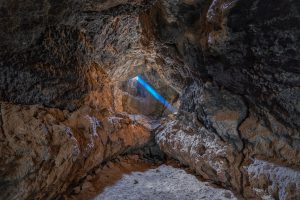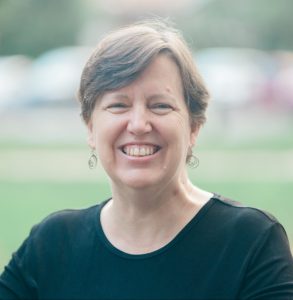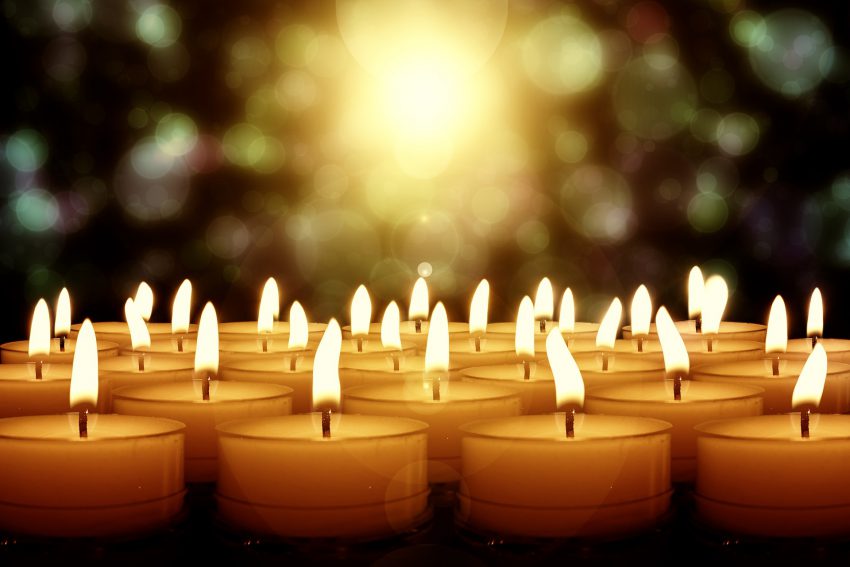On October 31 this year, the Seminary’s chapel team will host a service modeled on the Episcopal All Hallows’ Eve service, found in the Episcopal Book of Occasional Services, as part of the Seminary’s chapel program. While many Protestant denominations do not observe this particular holiday, PTS endeavors to introduce students to worship styles and spiritual practices from a variety of Christian traditions. The liturgy will include readings about mourning, memories, love, and hope and an invitation for participants to light votive candles and memorialize those they have lost. The holiday blends grief and remembrance of human mortality with joy and remembrance of the lives of the saints.
All Hallows’ Eve
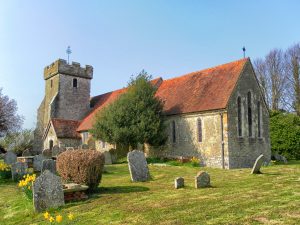 The origins of All Hallows’ Eve date back to pre-Christian traditions of commemorating the dead each year in autumn. Later, the Church also felt the need to commemorate the dead around this same time, and this led to the observance of All Saint’s Day – a happy day celebrating the lives of the saints. All Hallows’ Eve, the eve of All Saint’s Day, is a quieter, more contemplative observance. The service includes procession into the dimly-lit sanctuary, candle lighting, several scripture readings, and a number of responsorial Psalms and canticles, not unlike an Easter vigil service. Again like an Easter vigil, the All Hallows’ Eve order of worship begins on a somber note, includes times of remembrance, and culminates in a celebration—in the case of All Hallows’ Eve, the Te Deum prayer of praise to God and the corporate singing of For All the Saints.
The origins of All Hallows’ Eve date back to pre-Christian traditions of commemorating the dead each year in autumn. Later, the Church also felt the need to commemorate the dead around this same time, and this led to the observance of All Saint’s Day – a happy day celebrating the lives of the saints. All Hallows’ Eve, the eve of All Saint’s Day, is a quieter, more contemplative observance. The service includes procession into the dimly-lit sanctuary, candle lighting, several scripture readings, and a number of responsorial Psalms and canticles, not unlike an Easter vigil service. Again like an Easter vigil, the All Hallows’ Eve order of worship begins on a somber note, includes times of remembrance, and culminates in a celebration—in the case of All Hallows’ Eve, the Te Deum prayer of praise to God and the corporate singing of For All the Saints.
Episcopal Liturgy – A Service of Light and Presence
The practice of thinking about those who have gone before is a multifaceted experience. In the Episcopal tradition, All Hallows’ Eve is a time to both consider expectantly that God is preparing for the living a space in the heavenly kingdom of saints and remember and accept our own mortality and the mortality our loved ones. Light and presence are unifying themes which bring together the joyful and sorrowful facets of the service.
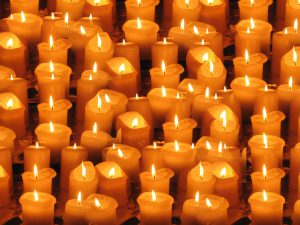 These themes of light and of presence are present throughout the liturgy. The service begins outside of the building, where a lit oil lamp marks the way into the sanctuary. The opening scripture reading is taken from a vespers service known as the “service of light,” and the call to worship is the phos hilaron (Greek, “gladdening light”), an ancient Byzantine hymn which the Episcopal tradition has adopted as its traditional candle-lighting hymn. The Service of the Word concludes with the song of the three young men found in Greek versions of the Book of Daniel, in which the three young men thrown into the fiery furnace sing praise to God, whose angel had come to be present with them in the furnace, as they walk unharmed in the midst of the flames. The service also features readings from 1 Samuel 28 (the witch of Endor), Job 4 (the vision of Eliphaz), Psalm 108 (a hymn Psalm including prayers of praise and of trust in God), Ezekiel 37 (the valley of dry bones), and Revelation 12 (the war in heaven).
These themes of light and of presence are present throughout the liturgy. The service begins outside of the building, where a lit oil lamp marks the way into the sanctuary. The opening scripture reading is taken from a vespers service known as the “service of light,” and the call to worship is the phos hilaron (Greek, “gladdening light”), an ancient Byzantine hymn which the Episcopal tradition has adopted as its traditional candle-lighting hymn. The Service of the Word concludes with the song of the three young men found in Greek versions of the Book of Daniel, in which the three young men thrown into the fiery furnace sing praise to God, whose angel had come to be present with them in the furnace, as they walk unharmed in the midst of the flames. The service also features readings from 1 Samuel 28 (the witch of Endor), Job 4 (the vision of Eliphaz), Psalm 108 (a hymn Psalm including prayers of praise and of trust in God), Ezekiel 37 (the valley of dry bones), and Revelation 12 (the war in heaven).
Especially notable is a pair of contemplative candle lighting practices that come between the Service of the Word and the celebration of the Lord’s Supper. Originally practiced in a Mennonite hospital, the full version of the practice includes ten readings accompanying the lighting of ten candles. The liturgy at PTS will feature four of these readings: those on the themes of mourning, memory, love, and hope. Then, participants are invited to approach the table, light votive candles, and say the names of those they wish to remember. After each name is spoken, the congregation responds: “They are present with us.” The sanctuary remains dim through this portion of the liturgy, and for three to five minutes, those present observe a contemplative time of remembrance in the presence of the candlelight.
Throughout the academic year, Seminary students collaborate to design chapel services as a part of the PTS Worship Program. Comprising students from various ecclesial traditions and led by the Rev. Kendra Buckwalter Smith, director of the Worship Program, the student chapel team draws upon a variety of worship styles, liturgical structures, and expressions of prayer to design worship experiences for the seminary community.
Read Next
